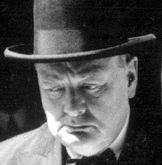 Glasgow, Sunday, October 14, 2001 [Pictures added by this website]
UK planned to wipe out Germany with anthrax Allies World War Two shame By George Rosie
AS THE world recoils at the horrific possibility of al-Qaeda terrorists waging anthrax war against United States citizens, the Sunday Herald can reveal that Britain manufactured five million anthrax cattle cakes during the second world war and planned to drop them on Germany in 1944. The aim of Operation Vegetarian was to wipe out the German beef and dairy herds and then see the bacterium spread to the human population. With people then having no access to antibiotics, this would have caused many thousands -- perhaps even millions -- of German men, women and children to suffer awful deaths. The anthrax cakes were tested on Gruinard Island, off Wester Ross, which was finally cleared of contamination in 1990. Operation VEGETARIAN was planned for the summer of 1944 but, in the event, it was abandoned as the Allies' Normandy invasion progressed successfully. Details of the wartime secret operation are contained in a series of War Office files (WO 188) at the Public Record Office in Kew. Some of the files are still classified . The man whose task was to carry out Operation Vegetarian was Dr Paul Fildes, director of the biology department at Porton Down near Salisbury in Wiltshire. Fildes had previously been in charge of the Medical Research Council's bacterial chemistry unit at Middlesex Hospital. In early 1942, Fildes began searching Britain for suppliers and manufacturers of linseed-oil cattle cake to make five million small cakes. Large quantities of the bacillus itself had to be produced, while special containers to carry the cattle cakes had to be designed and made. Some RAF bombers had to be modified to deliver the anthrax-infected payload. And all of it had to be done as cheaply as possible.
The anthrax was manufactured by the Ministry of Agriculture and Fisheries at its veterinary laboratory in Surrey. An Oxford academic named Dr E Schuster was set to work devising the pump to inject the bacilli into the cattle cakes. The Porton Down scientists settled on cube-shaped cardboard containers, 18cm square, to carry the infected foodstuff. Each held 400 cakes. They would be fitted with a steel handle 'of a size which enables the operator to grasp the handle without difficulty when wearing thick leather or moleskin gloves ...' Thirteen women were then recruited from various soap-making firms, sworn to secrecy and given the job of injecting the cattle cakes with anthrax spores. At the same time, Fildes and his team were working on the best way to deliver the diseased cattle feed to the German herds. The RAF's research unit came up with a simple solution -- easily made wooden trays that fitted on to aircraft flare chutes. Their Bomber Command Lancasters, Halifaxes and Stirlings were chosen for the job. By the beginning of 1944, Operation VEGETARIAN was ready to go. It was crucial to mount any attack in the summer months. Fildes said: 'The cattle must be caught in the open grazing fields when lush spring grass is on the wane.' 'Trials have shown that these tablets ... are found and consumed by the cattle in a very short time. 'Cattle are concentrated in the northern half of Oldenburg and northwest Hanover. Aircraft flying to and from Berlin will fly over 60 miles of grazing land.' Fildes calculated that, at an average ground speed of 300mph, the distance would be covered in 18 minutes. 'If one box of tablets is dispersed every two minutes, then each aircraft will be required to carry and disperse nine, or say 10, boxes.' One Lancaster bomber returning from a raid on Berlin would be able to scatter 4000 anthrax-infected cakes over a 60-mile swathe in less than 20 minutes. A dozen aircraft would have been enough to litter most of the north German countryside with anthrax spores. Operation VEGETARIAN was a seriously deadly project. But, by the time Fildes's operation was ready to go in
the summer of 1944, the Normandy invasion had taken place
and Allied armies were crashing through northern France and
up through Italy. The war against Nazi Germany was instead
being won by conventional means. At the end of 1945, five
million anthrax-infected cattle cakes were incinerated in
one of Porton Down's furnaces. Related file on this website:
|
 The
raw material for the cake was provided by the Olympia Oil
and Cake Company in Blackburn. The contract to cut the
cattle cake into small pieces went to J & E Atkinson of
Bond Street in London, perfumers and toilet-soap
manufacturers and suppliers to the royal family. The
Atkinsons calculated that they could produce 180,000 to
250,000 cakes, each 2.5cm in diameter and 10 grammes in
weight, in a 44-hour week. The price was to be between 12
and 15 shillings per thousand. The firm pledged to deliver
5,273,400 cakes by April 1943. By the middle of July 1942,
the Atkinsons informed Fildes that 'we are now producing at
the rate of 40,000 per day'.
The
raw material for the cake was provided by the Olympia Oil
and Cake Company in Blackburn. The contract to cut the
cattle cake into small pieces went to J & E Atkinson of
Bond Street in London, perfumers and toilet-soap
manufacturers and suppliers to the royal family. The
Atkinsons calculated that they could produce 180,000 to
250,000 cakes, each 2.5cm in diameter and 10 grammes in
weight, in a 44-hour week. The price was to be between 12
and 15 shillings per thousand. The firm pledged to deliver
5,273,400 cakes by April 1943. By the middle of July 1942,
the Atkinsons informed Fildes that 'we are now producing at
the rate of 40,000 per day'.